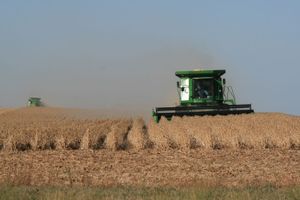U.S. Row-crop Harvest Remains Slowest in 10 Years
 The U.S. row-crop harvest remains the slowest it’s been in a decade, according to USDA NASS’ latest Crop Progress report released Monday.
The U.S. row-crop harvest remains the slowest it’s been in a decade, according to USDA NASS’ latest Crop Progress report released Monday.
Nationwide, corn harvest progressed 11 percentage points last week to reach 41% as of Sunday, 20 percentage points behind the five-year average of 61% and falling further behind the average pace than the previous week when harvest was 17 percentage points behind the five-year average. The pace of this year’s corn harvest remains the slowest since 2009 when only 20% of corn was harvested as of Oct. 25, said DTN Senior Analyst Dana Mantini.
“North Dakota is just 6% harvested, with South Dakota at 14% and Wisconsin 13% harvested,” Mantini said.
The condition of corn still in fields was rated 58% good to excellent, up 2 percentage points from 56% the previous week. The poor-to-very-poor category declined to just 12% from 14% the previous week.
Soybean harvest moved ahead 16 percentage points last week to reach 62% as of Sunday. That was 16 percentage points behind the five-year average of 78%, a slight improvement from last Monday’s report, when harvest was running 18 percentage points behind average. As with corn, the pace of this year’s soybean harvest remains the slowest since 2009 when 44% of the crop was harvested as of Oct. 25.
While row-crop harvest remained behind the average pace, winter wheat progress stayed near, to slightly ahead of, the average pace last week. As of Sunday, 85% of winter wheat was planted, slightly ahead of the five-year average of 82%. Winter wheat emerged was estimated at 63%, near the five-year average of 64%.
In its first condition rating for the 2020 winter wheat crop, NASS estimated 56% of winter wheat was in good-to-excellent condition, 3 percentage points better than last year’s rating of 53% good to excellent at the same time of year.
Sorghum mature was estimated at 96%, ahead of the average of 94%. Sorghum harvested reached 65%, also ahead of the five-year average of 62%.
Cotton bolls opening was estimated at 95%, ahead of the average of 93%. Cotton harvested was estimated at 46%, also ahead of the five-year average of 43%. Rice harvested was 97%, just slightly behind the average of 98%.
To view weekly crop progress reports issued by National Ag Statistics Service offices in individual states, visit http://www.nass.usda.gov/…. Look for the U.S. map in the “Find Data and Reports by” section and choose the state you wish to view in the drop-down menu. Then look for that state’s “Crop Progress & Condition” report.
| National Crop Progress Summary | ||||
| This | Last | Last | 5-Year | |
| Week | Week | Year | Avg. | |
| Corn Mature | 93 | 86 | 100 | 99 |
| Corn Harvested | 41 | 30 | 61 | 61 |
| Soybeans Dropping Leaves | 97 | 94 | 100 | 99 |
| Soybeans Harvested | 62 | 46 | 69 | 78 |
| Winter Wheat Planted | 85 | 77 | 77 | 82 |
| Winter Wheat Emerged | 63 | 53 | 62 | 64 |
| Cotton Bolls Opening | 95 | 93 | 91 | 93 |
| Cotton Harvested | 46 | 40 | 43 | 43 |
| Sorghum Mature | 96 | 92 | 93 | 94 |
| Sorghum Harvested | 65 | 49 | 52 | 62 |
| Rice Harvested | 97 | 93 | 95 | 98 |
**
| National Crop Condition Summary | |||||||||||||||
| (VP = Very Poor; P = Poor; F = Fair; G = Good; E = Excellent) | |||||||||||||||
| This Week | Last Week | Last Year | |||||||||||||
| VP | P | F | G | E | VP | P | F | G | E | VP | P | F | G | E | |
| Corn | 3 | 9 | 30 | 47 | 11 | 4 | 10 | 30 | 45 | 11 | 4 | 8 | 20 | 48 | 20 |
| Winter Wheat | 4 | 9 | 31 | 44 | 12 | NA | NA | NA | NA | NA | 3 | 11 | 33 | 45 | 8 |
| Cotton | 5 | 15 | 40 | 33 | 7 | 5 | 18 | 36 | 33 | 8 | 18 | 16 | 31 | 27 | 8 |
**
| National Soil Moisture Condition – 48 States | ||||||||||||
| (VS = Very Short; SH = Short; AD = Adequate; SR = Surplus) | ||||||||||||
| This Week | Last Week | Last Year | ||||||||||
| VS | SH | AD | SR | VS | SH | AD | SR | VS | SH | AD | SR | |
| Topsoil Moisture | 6 | 13 | 62 | 19 | 8 | 16 | 59 | 17 | 4 | 9 | 71 | 16 |
| Subsoil Moisture | 7 | 15 | 63 | 15 | 8 | 17 | 60 | 15 | 6 | 13 | 68 | 13 |
Anthony Greder can be reached at anthony.greder@dtn.com
Follow him on Twitter @AGrederDTN
Source: Anthony Greder, DTN
